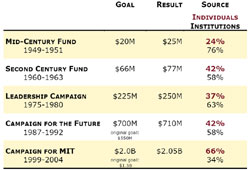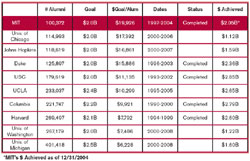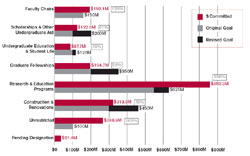| home this issue archives editorial board contact us faculty website |

| Vol.
XVII No.
4 March/April 2005 |
| contents |
| Printable Version |
A Retrospective Look at The Campaign for MIT
The end of the calendar year marked the conclusion of the Institute's seven-year capital campaign. Reaching our $2 billion goal with another $53 million in change to our credit, The Campaign for MIT brought an important transformation in private support to MIT and set the stage for a new level of fundraising in the years to come.
Back in 1994 when Chuck Vest and I first began quiet conversations about a campaign, we were only two years out from the completion of the $710 million Campaign for the Future. But Chuck was very concerned about the federal funding climate in Washington and it was increasingly clear that MIT required additional financial wherewithal for undergraduate scholarships, graduate fellowships, faculty chairs, and renewing the campus infrastructure. And so began a parallel process of assessing the demand and supply side of MIT's agenda. Then Provost Joel Moses led the deans and faculty in a review of the most critical institutional needs while the senior leaders in Resource Development analyzed MIT's fundraising history and the current trends that would inform how ambitious we could be in seeking support from our donor constituency.
Historically, and in contrast to the Ivy League schools, MIT has relied heavily on support from corporate and foundation donors. But in 1997, we knew that to succeed with a campaign that met MIT's needs would require turning to our alumni in unprecedented ways. As we set the stage for a $1.5 billion campaign, we knew we would need to raise at least $1 billion from individual donors – which at that time was twice the cumulative giving of all of MIT's living alumni. With a strong economy and Chuck's optimism and leadership, we set forth on a course that took us from the height of the market in the late '90s through the uncertain economic and political landscape that followed shortly thereafter. Happily, our alumni and friends more than met the challenge. When we reached our original target two years early, we took a deep breath and raised the goal to $2 billion, and in doing so joined the ranks of a small number of topflight fundraising institutions.

(click on image to enlarge)
MIT, of course, is a younger institution than many of those with which we compete and compare ourselves. And our fundraising program reflects our origins and an evolution that spans 55 years and five capital campaigns. The Mid-Century Fund, launched in 1949, raised $25 million, three-quarters of which came from corporations and foundations. During the next three campaigns, this constituency continued to provide roughly 60% of our fund-raising dollars. In recent years, as we greatly expanded and strengthened engagement with our alumni, we shifted the balance dramatically, and in the just completed campaign 66% of our gifts – $1.35 billion – came from individual donors.

(click on image to enlarge)
During the course of The Campaign for MIT, we found ourselves in the select company of just nine other universities with campaign goals of $2 billion. Most had alumni populations considerably larger than ours; most had large professional schools – like medicine and law; many had big-time athletic programs. All of these factors shape an institution's fundraising culture. If you calculate these campaign goals on a per alumnus basis, MIT's tops the list at $19,976 per graduate, which is an extraordinary achievement in this peer group.
Overall, the campaign benefited from the generosity of some 65,000 individual donors. Fifty-four percent of our alumni participated in the campaign; and gifts of $1 million or more from 208 alumni and friends totaled $1 billion. Members of the MIT Corporation contributed $425 million – 21% of the campaign, and our corporate and foundation constituency added $650 million.

(click on image to enlarge)
We did extremely well in meeting some of our goals and wish we could've done a bit better in some other areas. But at the end of the day, one-in-five faculty chairs were endowed during the campaign, and 275 new scholarship funds and 345 endowed and expendable graduate fellowships were created. The campaign helped to support the addition of nearly one-and-a-half million square feet of space in five new buildings. And cash giving to MIT on an annual basis more than doubled over these seven years.
These results naturally involved close collaboration among the staff in Resource Development, the Alumni Association, and our school-based fundraising colleagues. They also reflect the generous participation of many faculty across the Institute who worked with us in a whole range of ways. Our alumni volunteers also made important contacts and contributions to the effort and we all owe a great debt of gratitude to Ray Stata and Alex d'Arbeloff, both of whom turned in yeoman service meeting alumni all around the country on MIT's behalf.
Above and beyond the dollar and donor metrics we use to measure a campaign's success, there are two additional factors that will give shape to MIT in the years ahead. First, we are reminded time and again about the importance of long-standing relationships. Having been a member of the MIT community for nearly 25 years, I was privileged to have the opportunity to work with Jim Killian, Jerry Wiesner, and Howard Johnson in the early 1980s. And it was a great pleasure for me to see gifts arrive all these years later from people who were brought closer to MIT through their efforts. Many of our most generous donors in the last 7 years are alumni whose real engagement with the Institute began during the last campaign through the efforts of Paul Gray and my predecessors Glenn Strehle and Sam Goldblith. And the number of people whose respect and regard for MIT grew even greater during Chuck Vest's 14-year presidency is beyond calculation. As Susan Hockfield begins her tenure at MIT, she inherits a legacy of strong leadership and a wonderful community of Institute supporters which will serve MIT well in the years to come.
Another of the less tangible but vitally important by-products of this campaign is the new level of confidence it gave all of us in MIT's ability to attract high-level gifts and to appeal to a broad constituency of supporters around the country and around the world. Taken together, this legacy of leadership and generosity combined with a heightened confidence sets the stage for an ambitious and bold next chapter in private support to MIT.
| Back to top | |
| Send your comments |
| home this issue archives editorial board contact us faculty website |